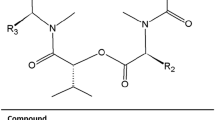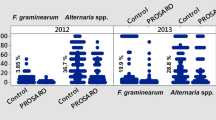Abstract
The occurrence of Alternaria and Fusarium fungi in wheat and barley grain obtained from the Ural Region was analyzed. The DNA content of fungi belonging to two sections of the genus Alternaria, and four species of the genus Fusarium, which are prevailing in the grain mycobiota, was analyzed by quantitative PCR. Differences in the occurrence and abundance of fungal biomass in the grain of two cereals were found. The DNA content of Alternaria fungi of the section Infectoriae, as well as F. graminearum DNA and F. sporotrichioides DNA in wheat grain was significantly higher than in barley grain. On the contrary, the DNA of F. avenaceum and DNA of F. poae were more often detected in barley grain. The current information obtained by the HPLC–MS/MS method on grain contamination with mycotoxins that revealed data on both regulated and emerging toxic metabolites was presented. The diversity of fungal secondary metabolites in wheat grain included 13 mycotoxins and was higher, than in barley. Of the 23 analyzed mycotoxins, tentoxin, tenuazonic acid, HT-2 toxin, and beauvericin were detected more often than others. Statistically significant positive correlations between Alternaria and Fusarium fungi and their mycotoxins were established, that indicate the mutual adaptation of these organisms to each other in the grain mycobiota.


Similar content being viewed by others
REFERENCES
Toropova, E.Yu., Kirichenko, A.A., Kazakova, O.A., and Porsev, I.N., Alternaria disease of grain of spring wheat and barley in Western Siberia and Eastern Trans-Urals, Zashch. Karantin Rast., 2015, no. 1, pp. 20–22.
Piryazeva, E.A., Kononenko, G.P., and Burkin, A.A., Affection of coarse fodders by toxigenic Fusarium fungi, S-kh. Biol., 2016, vol. 51, no. 6, pp. 937–945. https://doi.org/10.15389/agrobiology.2016.6.937rus
Gagkaeva, T., Gavrilova, O., Orina, A., Lebedin, Y., Shanin, I., Petukhov, P., and Eremin, S., Analysis of toxigenic Fusarium species associated with wheat grain from three regions of Russia: Volga, ural, and West Siberia, Toxins, 2019, vol. 11, no. 5, p. 252. https://doi.org/10.3390/toxins11050252
Frisvad, J.C., Andersen, B., and Thrane, U., The use of secondary metabolite profiling in chemotaxonomy of filamentous fungi, Mycol. Res., 2008, vol. 112, pp. 231– 240. https://doi.org/10.1016/j.mycres.2007.08.018
Zwickel, T., Kahl, S.M., Rychlik, M., and Müller, M.E.H., Chemotaxonomy of mycotoxigenic small-spored Alternaria fungi – do multitoxin mixtures act as an indicator for species differentiation?, Front. Microbiol., 2018, vol. 9, p. 1368. https://doi.org/10.3389/fmicb.2018.01368
Magan, N., Medina, A., and Aldred, D., Possible climate-change effects on mycotoxin contamination of food crops pre- and postharvest, Plant Pathol., 2011, vol. 60, no. 1, pp. 150–163. https://doi.org/10.1111/j.1365-3059.2010.02412.x
Fraeyman, S., Croubels, S., Devreese, M., and Antonissen, G., Emerging Fusarium and Alternaria mycotoxins: Occurrence, toxicity and toxicokinetics, Toxins, 2017, vol. 9, no. 7, p. E228. https://doi.org/10.3390/toxins9070228
Tralamazza, S.M., Piacentini, K.C., Iwase, C.H.T., and de Oliveira Rocha, L., Toxigenic Alternaria species: Impact in cereals worldwide, Curr. Opin. Food Sci., 2018, vol. 23, p. 57. https://doi.org/10.1016/j.cofs.2018.05.002
D’Mello, J.P.F., Placinta, C.M., and Macdonald, A.M.C., Fusarium mycotoxins: A review of global implications for animal health, welfare and productivity, Anim. Feed Sci. Technol., 1999, vol. 80, pp. 183–205. https://doi.org/10.1016/S0377-8401(99)00059-0
Kononenko, G.P., Burkin, A.A., and Zotova, E.V., Mycotoxilogical monitoring. Part 2. Wheat, barley, oat and maize grain, Vet. Sci. Today, 2020, vol. 2, no. 33, pp. 139–145. https://doi.org/10.29326/2304-196X-2020-2-33-139-145
Yli-Mattila, T., Paavanen-Huhtala, S., Jestoi, M., Parikka, P., Hietaniemi, V., Gagkaeva, T., Sarlin, T., Haikara, A., Laaksonen, S., and Rizzo, A., Real-time PCR detection and quantification of Fusarium poae, F. graminearum, F. sporotrichioides and F. langsethiae in cereal grains in Finland and Russia, Arch. Phytopathol. Plant Prot., 2008, vol. 41, no. 4, pp. 243–260. https://doi.org/10.1080/03235400600680659
Karakotov, S.D., Arshava, N.V., and Bashkatova, M.B., Monitoring and control of wheat diseases in the South Trans-Urals, Zashch. Karantin Rast., 2019, no. 7, pp. 18–25.
Malachová, A., Sulyok, M., Beltrán, E., Berthillera, F., and Krska, R., Optimization and validation of a quantitative liquid chromatography-tandem mass spectrometric method covering 295 bacterial and fungal me tabolites including all regulated mycotoxins in four model food matrices, J. Chromatogr., A, 2014, vol. 1362, pp. 145–156. https://doi.org/10.1016/j.chroma.2014.08.037
Orina, A.S., Gavrilova, O.P., Gagkaeva, T.Yu., and Gannibal, Ph.B., Micromycetes Alternaria spp. and Bipolaris sorokiniana and mycotoxins in the grain from the Ural Region, Mikol. Fitopatol., 2020, vol. 54, no. 5, pp. 365–377. https://doi.org/10.31857/S0026364820050086
Yli-Mattila, T., Paavanen-Huhtala, S., Parikka, P., Jestoi, M., Klemsdal, S.S., and Rizzo, A., Genetic variation, real-time PCR, metabolites and mycotoxins of Fusarium avenaceum and related species, Mycotox. Res., 2006, vol. 22, pp. 79–86. https://doi.org/10.1007/BF02956768
Orina, A.S., Gavrilova, O.P., Gagkaeva, T.Yu., and Loskutov, I.G., Symbiotic relationships between aggressive Fusarium and Alternaria fungi colonizing oat grain, S-kh. Biol., 2017, vol. 52, no. 5, pp. 986–994. https://doi.org/10.15389/agrobiology.2017.5.986rus
Xu, W., Xiaomin, H., Li, F., and Zhang, L., Natural occurrence of Alternaria toxins in the 2015 wheat from Anhui Province, China, Toxins, 2016, vol. 8, p. 308. https://doi.org/10.3390/toxins8110308
Vogelgsang, S., Sulyok, M., Hecker, A., Jenny, E., and Krska, R., Schuhmacher, R., and Forrer, H.R., Toxigenicity and pathogenicity of Fusarium poae and Fusarium avenaceum on wheat, Eur J. Plant Pathol., 2008, vol. 122, pp. 265–276. https://doi.org/10.1007/s10658-008-9279-0
Schuhmacher-Wolz, U., Heine, K., and Schneider, K., Report on toxicity data on trichothecene mycotoxins HT-2 and T-2 toxins, EFSA Supp. Publ., 2010, vol. 7. https://doi.org/10.2903/sp.efsa.2010.EN-65
Kosiak, B., Torp, M., Skjerve, E., and Andersen, B., Alternaria and Fusarium in Norwegian grains of reduced quality – a matched pair sample study, Int. J. Food Microbiol., 2004, vol. 93, no. 1, pp. 51–62. https://doi.org/10.1016/j.ijfoodmicro.2003.10.006
Sass, V., Milles, J., Kraemer, J., and Prange, A., Competitive interactions of Fusarium graminearum and Alternaria alternata in vitro in relation to deoxynivalenol and zearalenone production, J. Food Agric. Environ., 2007, no. 1, pp. 257–261. https://doi.org/10.1234/4.2007.771
Müller, M.E., Urban, K., Köppen, R., Siegel, D., Korn, U., and Koch, M., Mycotoxins as antagonistic or supporting agents in the interaction between phytopathogenic Fusarium and Alternaria fungi, World Mycotoxin J., 2015, vol. 8, pp. 311–321. https://doi.org/10.3920/WMJ2014.1747
ACKNOWLEDGMENTS
We are grateful to the managers of the Russian Branches of Syngenta and Bayer Crop Science for their help with the grain samples collection.
Funding
This work was financially supported by the Russian Science Foundation (project no. 19-76-30005).
Author information
Authors and Affiliations
Corresponding author
Ethics declarations
COMPLIANCE WITH ETHICAL STANDARDS
The study was carried out without the use of animals and without the involvement of people as subjects.
CONFLICT OF INTERESTS
The authors declare no conflicts of interest.
About this article
Cite this article
Gavrilova, O.P., Orina, A.S., Gogina, N.N. et al. Co-occurrence of the Metabolites of Alternaria and Fusarium Fungi Associated with Small-Grain Cereals. Russ. Agricult. Sci. 47, 37–41 (2021). https://doi.org/10.3103/S1068367421010079
Received:
Accepted:
Published:
Issue Date:
DOI: https://doi.org/10.3103/S1068367421010079




